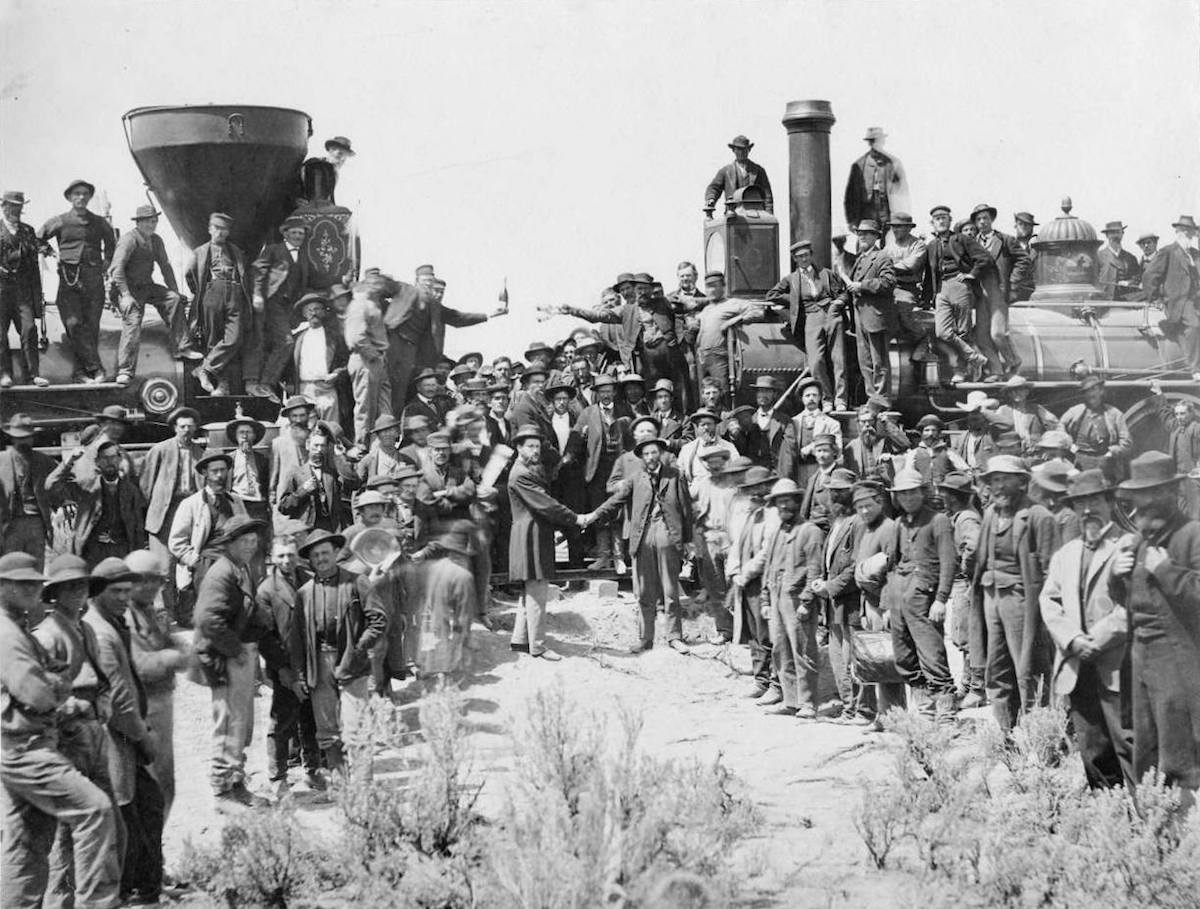Promontory Summit
On May 10, 1869, the presidents of the Union Pacific and Central Pacific railroads and other dignitaries and interested persons met in Promontory, Utah Territory, to drive a ceremonial spike into a rail line that connected their railroads. This was the first time that travel by rail from one side of the United States to the other was possible without any need for lengthy wagon train or boat journeys. With the railroad's completion, a trip across the nation went from up to six months on foot, on an animal, or in an animal-pulled wagon to as little as eight days from New York, New York to San Francisco, California.
The first transcontinental railroad connected Sacramento, California, and Omaha, Nebraska. In 1873, a coast-to-coast rail journey on this route was completed.[1] In 1870, a different coast-to-coast line was completed in Colorado.
The Need for a Transcontinental Railway
The need for a transcontinental railway was acknowledged by at least 1832. In 1853, Congress appropriated funds to survey possible routes. In 1862, Congress selected the Union Pacific and the Central Pacific to build the transcontinental line and work began in 1866. Most of the Union Pacific laborers were Civil War veterans of Irish descent[2] and recently released slaves. The Central Pacific laborers were predominantly Chinese.
Brigham Young’s Support
Members of The Church of Jesus Christ of Latter-day Saints used railroad employment as a means of income. Brigham Young supported the effort to create a transcontinental railroad and believed it would benefit the Saints in Utah Territory with income and as a way for members to more easily join the body of the Saints. In 1863, he purchased $5,000 worth of stock in the railroad.[3] He welcomed surveying parties and, when necessary, he provided tools and supplies. He contracted with the Union Pacific to build the railroad through Echo and Weber Canyons. He attempted to urge officials to build a direct line to Salt Lake City. After the transcontinental railroad was completed at Promontory Summit, then moved to Ogden, Young began the Central Utah Railroad project to connect Ogden and Salt Lake City.[4]
The Ceremony at Promontory Summit
According to Wikipedia,
- The event at Promontory Summit was billed as the "wedding of the rails" and was officiated by the Reverend John Todd. Four precious metal spikes were ceremoniously driven (gently tapped with a special spike maul sporting a solid silver head into pre-drilled holes in the Laurelwood tie); one was the golden spike issued by Californian David Hewes, one was a second solid gold spike issued by the San Francisco Newsletter Newspaper, one was a solid silver spike issued by the State of Nevada, and one was an iron spike plated with silver on the shaft and gold on the top issued by Arizona Territory and presented by Arizona Territorial Governor Anson P.K. Safford from the Territorial Capitol of Prescott. In 1898, the golden spike was donated to the Leland Stanford Junior University Museum. The second Golden Spike and the Laurelwood Tie were destroyed in the 1906 San Francisco earthquake and fire, which also destroyed the San Francisco Newsletter Newspaper Offices where these artifacts were on display. Stanford University loaned the original 1869 gold spike to Cecil B. DeMille for the film Union Pacific (1939). It was held aloft in the scene commemorating the actual event, although a brass prop was used for the hammering sequence. The only marks on The Golden Spike were caused by a Union Army Officer who struck the Spike with the pommel of his sword four times on the ride back to California. Nobody tried to fully drive 17.6 Carat Solid Gold Spikes or any of the precious metal spikes into a wooden tie. Four holes had been drilled into the Laurelwood tie to "hold" the spikes while Stanford and UPRR's Thomas Durant gently tapped them before the Spikes and the Laurelwood Tie were removed to make way for a regular pine wood tie and four regular iron spikes, the last one was wired to the Transcontinental Telegraph Line.[5]
Tied to and also important to the transcontinental railroad effort was the transcontinental telegraph line, which ran parallel to the tracks.
Leland Stanford (CPR) and Thomas Durant (UPRR) were “supposed to strike the last iron spike with a regular iron spike hammer, also wired to the Telegraph Line, to send a signal from coast-to-coast as the job was done. Stanford missed the Spike, hitting the wooden tie instead; however, the telegraph operator hit his key as though Stanford had hit the spike. Durant missed the spike and the tie entirely; but likewise, the operator hit his key so the Nation would not know the difference. Then the operator sent the message D-O-N-E!”[6] The New York Times declared the next day, “the continent was spanned with iron.”[7]
In January 1870, the train crews from the Central Pacific and Union Pacific had been relocated to Ogden, Utah, where Union Station had effectively become the meeting point of the two railroads. By June 1870, the population at Promontory Summit had been reduced to about 120 people. Most were employees of the Central Pacific railroad.
Beginning in 1902, after the Southern Pacific Railroad Company had acquired Central Pacific operations, a wooden railroad trestle was built across the Great Salt Lake from Ogden to Lucin, completely bypassing Promontory Summit. On September 8, 1942, an “unspiking” ceremony was held “to commemorate the lifting of the last rail over Promontory Summit.” The old steel rails were used for as resources during World War II.
Re-enactments of connecting the west and east at Promontory Summit are held each year, and in 1965, the Golden Spike National Historic Site was created there.
